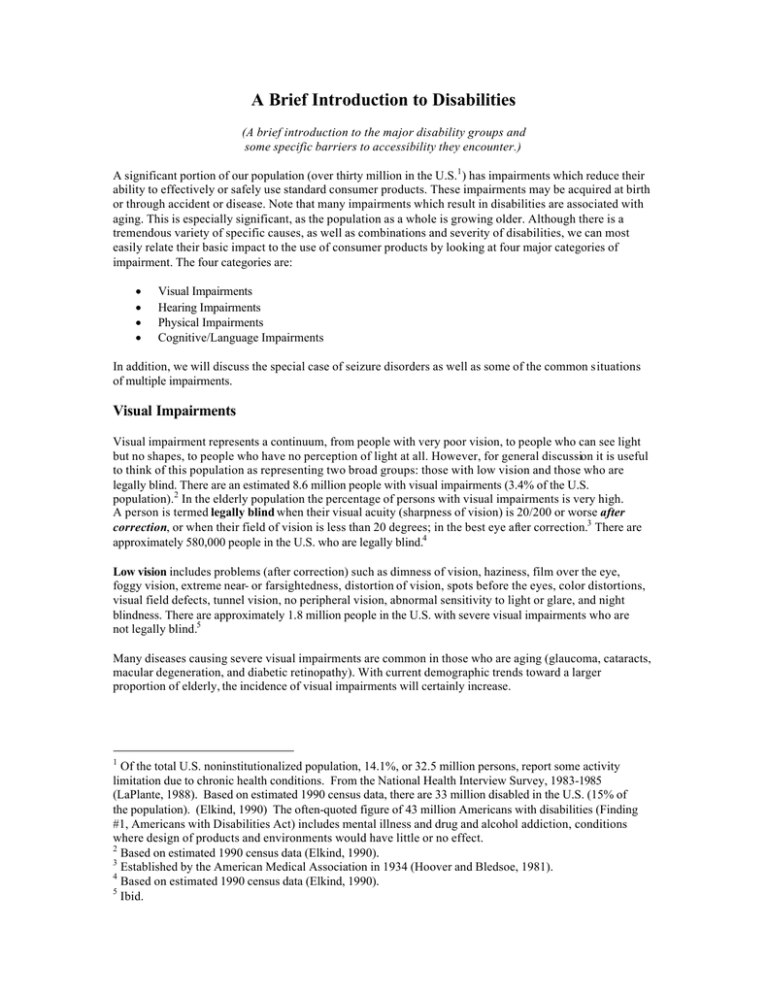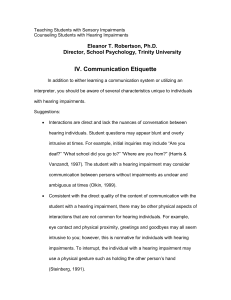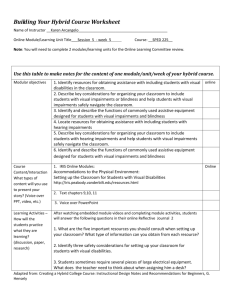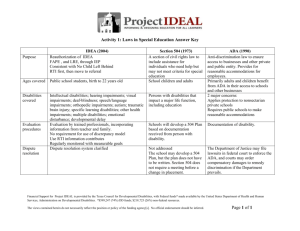A Brief Introduction to Disabilities
advertisement

A Brief Introduction to Disabilities (A brief introduction to the major disability groups and some specific barriers to accessibility they encounter.) A significant portion of our population (over thirty million in the U.S.1 ) has impairments which reduce their ability to effectively or safely use standard consumer products. These impairments may be acquired at birth or through accident or disease. Note that many impairments which result in disabilities are associated with aging. This is especially significant, as the population as a whole is growing older. Although there is a tremendous variety of specific causes, as well as combinations and severity of disabilities, we can most easily relate their basic impact to the use of consumer products by looking at four major categories of impairment. The four categories are: • • • • Visual Impairments Hearing Impairments Physical Impairments Cognitive/Language Impairments In addition, we will discuss the special case of seizure disorders as well as some of the common situations of multiple impairments. Visual Impairments Visual impairment represents a continuum, from people with very poor vision, to people who can see light but no shapes, to people who have no perception of light at all. However, for general discussion it is useful to think of this population as representing two broad groups: those with low vision and those who are legally blind. There are an estimated 8.6 million people with visual impairments (3.4% of the U.S. population).2 In the elderly population the percentage of persons with visual impairments is very high. A person is termed legally blind when their visual acuity (sharpness of vision) is 20/200 or worse after correction, or when their field of vision is less than 20 degrees; in the best eye after correction.3 There are approximately 580,000 people in the U.S. who are legally blind.4 Low vision includes problems (after correction) such as dimness of vision, haziness, film over the eye, foggy vision, extreme near- or farsightedness, distortion of vision, spots before the eyes, color distortions, visual field defects, tunnel vision, no peripheral vision, abnormal sensitivity to light or glare, and night blindness. There are approximately 1.8 million people in the U.S. with severe visual impairments who are not legally blind.5 Many diseases causing severe visual impairments are common in those who are aging (glaucoma, cataracts, macular degeneration, and diabetic retinopathy). With current demographic trends toward a larger proportion of elderly, the incidence of visual impairments will certainly increase. 1 Of the total U.S. noninstitutionalized population, 14.1%, or 32.5 million persons, report some activity limitation due to chronic health conditions. From the National Health Interview Survey, 1983-1985 (LaPlante, 1988). Based on estimated 1990 census data, there are 33 million disabled in the U.S. (15% of the population). (Elkind, 1990) The often-quoted figure of 43 million Americans with disabilities (Finding #1, Americans with Disabilities Act) includes mental illness and drug and alcohol addiction, conditions where design of products and environments would have little or no effect. 2 Based on estimated 1990 census data (Elkind, 1990). 3 Established by the American Medical Association in 1934 (Hoover and Bledsoe, 1981). 4 Based on estimated 1990 census data (Elkind, 1990). 5 Ibid. Functional Limitations Caused by Visual Impairments Those who are legally blind may still retain some perception of shape and contrast or of light vs. dark (the ability to locate a light source), or they may be totally blind (having no awareness of environmental light). Those with visual impairments have the most difficulty with visual displays and other visual output (e.g., hazard warnings). In addition, there are problems in utilizing controls where labeling or actual operation is dependent on vision (e.g., where eye-hand coordination is required, as with a computer "mouse"). Written operating instructions and other documentation may be unusable, and there can be difficulties in manipulation (e.g., insertion/placement, assembly). Because many people with visual impairments still have some visual capability, many of them can read with the assistance of magnifiers, bright lighting and glare reducers. Many such people with low vision are helped immensely by use of larger lettering, sans-serif typefaces, and high contrast coloring. Those with color blindness may have difficulty differentiating between certain color pairs. This generally doesn't pose much of a problem except in those instances when information is color coded or where color pairs are chosen which result in poor figure ground contrast. Key coping strategies for people with more severe visual impairments include the use of braille and large raised lettering. Note, however, that braille is preferred by only 10% of blind people (normally those blind from early in life). Raised lettering must be large and is therefore better for indicating simple labels than for extensive text. Hearing Impairments Hearing impairment is one of the most prevalent chronic disabilities in the U.S. Approximately 22 million people in the U.S. (8.2%) have hearing impairments. Of those, 2.4 million have severe to profound impairments.6 Hearing impairment means any degree and type of auditory disorder, while deafness means an extreme inability to discriminate conversational speech through the ear. Deaf people, then, are those who cannot use their hearing for communication. People with a lesser degree of hearing impairment are called hard of hearing.7 Usually, a person is considered deaf when sound must reach at least 90 decibels (5 to 10 times louder than normal speech) to be heard, and even amplified speech cannot be understood. Hearing impairments can be found in all age groups, but loss of hearing acuity is part of the natural aging process. 23% of those aged 65 to 74 have hearing impairments, while almost 40% over age 75 have hearing impairments.8 The number of individuals with hearing impairments will increase with the increasing age of the population and the increase in the severity of noise exposure. Hearing impairment may be sensorineural or conductive. Sensorineural hearing loss involves damage to the auditory pathways within the central nervous system, beginning with the cochlea and auditory nerve, and including the brain stem and cerebral cortex (this prevents or disrupts interpretation of the auditory signal). Conductive hearing loss is damage to the outer or middle ear which interferes with sound waves reaching the cochlea. Causes include heredity, infections, tumors, accidents and aging (presbycusis, or "old hearing").9 6 Ibid. Schein, 1981. 8 Schow, 1978. 9 Schein, 1981. 7 Functional Limitations Caused by Hearing Impairments The primary difficulty for individuals with hearing impairment in using standard products is receiving auditory information. This problem can be compensated for by presenting auditory information redundantly in visual and/or tactile form. If this is not feasible, an alternative solution to this problem would be to provide a mechanism, such as a jack, which would allow the user to connect alternative output devices. Increasing the volume range and lowering the frequency of products with high pitched auditory output would be helpful to some less severely impaired individuals. (Progressive hearing loss usually occurs in higher frequencies first.) Although not prevalent yet, there is much talk of using voice input on commercial products in the future. This, too, will present a problem for many deaf individuals. While many have some residual speech, which they work to maintain, those who are deaf from birth or a very early age often are also nonspeaking or have speech that cannot be recognized using current voice input technology. Thus, alternatives to voice input will be necessary to these individuals to access products with voice input. Familiar coping strategies for hearing impaired people include the use of hearing aids, sign language, lipreading and TDD's (telecommunication devices for the deaf). Some hearing aids are equipped with a "Tcoil" as well, which provides direct inductive coupling with a second coil (such as in a telephone receiver) in order to reduce ambient noise. Some other commercial products could make use of this capability. ASL (American Sign Language) is commonly used by people who are deaf. It should be noted, however, that this is a completely different language from English. Thus, deaf people who primarily use ASL may understand English only as a second language, and may therefore not be as proficient with English as native speakers. Finally, telecommunication devices for the deaf (TDD's) are becoming more common in households and businesses as a means for deaf and hard of hearing people to communicate over the phone. TDD's have always used the Baudot code, but newer ones receive both Baudot and ASCII. Physical Impairments Functional Limitations Caused by Physical Impairments Problems faced by individuals with physical impairments include poor muscle control, weakness and fatigue, difficulty walking, talking, seeing, speaking, sensing or grasping (due to pain or weakness), difficulty reaching things, and difficulty doing complex or compound manipulations (push and turn). Individuals with spinal cord injuries may be unable to use their limbs and may use "mouthsticks" for most manipulations. Twisting motions may be difficult or impossible for people with many types of physical disabilities (including cerebral palsy, spinal cord injury, arthritis, multiple sclerosis, muscular dystrophy, etc.). Some individuals with severe physical disabilities may not be able to operate even well-designed products directly. These individuals usually must rely on assistive devices which take advantage of their specific abilities and on their ability to use these assistive devices with standard products. Commonly used assistive devices include mobility aids (e.g., crutches, wheelchairs), manipulation aids (e.g., prosthetics, orthotics, reachers) communication aids (e.g., single switch-based artificial voice), and computer/device interface aids (e.g., eyegaze-operated keyboard) . Nature and Causes of Physical Impairments Neuromuscular impairments include: • • paralysis (total lack of muscular control in part or most of the body), weakness (paresis; lack of muscle strength, nerve enervation, or pain), and • interference with control, via spasticity (where muscles are tense and contracted), ataxia (problems in accuracy of motor programming and coordination), and athetosis (extra, involuntary, uncontrolled and purposeless motion). Skeletal impairments include joint movement limitations (either mechanical or due to pain), small limbs, missing limbs, or abnormal trunk size. Some major causes of these impairments are: Arthritis. Arthritis is defined as pain in joints, usually reducing range of motion and causing weakness. Rheumatoid arthritis is a chronic syndrome. Osteoarthritis is a degenerative joint disease. 31.6 million people in the U.S. suffer from rheumatic disease. The incidence of all forms of arthritis is now estimated at 900,000 new cases per year.10 Cerebral Palsy (CP). Cerebral palsy is defined as damage to the motor areas of the brain prior to brain maturity (most cases of CP occur before, during or shortly following birth). There are more than 750,000 in the U.S. with CP (children and adults), and 15,000 infants are born each year with CP.11 CP is a type of injury, not a disease (although it can be caused by a disease), and does not get worse over time; it is also not "curable." Some causes of cerebral palsy are high temperature, lack of oxygen, and injury to the head. The most common types are: (1) spastic, where the individual moves stiffly and with difficulty, (2) ataxic, characterized by a disturbed sense of balance and depth perception, and (3) athetoid, characterized by involuntary, uncontrolled motion. Most cases are combinations of the three types. Spinal Cord Injury. Spinal cord injury can result in paralysis or paresis (weakening). The extent of paralysis/paresis and the parts of the body effected are determined by how high or low on the spine the damage occurs and the type of damage to the cord. Quadriplegia involves all four limbs and is caused by injury to the cervical (upper) region of the spine; paraplegia involves only the lower extremities and occurs where injury was below the level of the first thoracic vertebra (mid-lower back). There are 150,000 to 175,000 people with spinal cord injuries in the U.S., with projected annual increases of 7,000 - 8,000. 47% of spinal cord injuries result in paraplegia; 53% in quadriplegia. Car accidents are the most frequent cause (38%), followed by falls and jumps (16%) and gunshot wounds (13%).12 Head Injury (cerebral trauma). The term "head injury" is used to describe a wide array of injuries, including concussion, brain stem injury, closed head injury, cerebral hemorrhage, depressed skull fracture, foreign object (e.g., bullet), anoxia, and post-operative infections. Like spinal cord injuries, head injury and also stroke often results in paralysis and paresis, but there can be a variety of other effects as well. Currently about one million Americans (1 in 250) suffer from effects of head injuries, and 400,000 600,000 people sustain a head injury each year. However, many of these are not permanently or severely disabled. Stroke (cerebral vascular accident; CVA). The three main causes of stroke are: thrombosis (blood clot in a blood vessel blocks blood flow past that point), hemorrhage (resulting in bleeding into the brain tissue; associated with high blood pressure or rupture of an aneurysm), and embolism (a large clot breaks off and blocks an artery). The response of brain tissue to injury is similar whether the injury results from direct trauma (as above) or from stroke. In either case, function in the area of the brain affected either stops altogether or is impaired.13 Loss of Limbs or Digits (Amputation or Congenital). This may be due to trauma (e.g., explosions, mangling in a machine, severance, burns) or surgery (due to cancer, peripheral arterial disease, diabetes). Usually prosthetics are worn, although these do not result in full return of function. The National Center for Health Statistics of the U.S. Public Health Service estimated a prevalence of 311,000 amputees in 1970. An 10 Nicholas, 1981. United Cerebral Palsy Association, Inc., 1975. 12 National Institute of Handicapped Research, 1983. 13 Anderson, 1981. 11 incidence of approximately 43,000 new amputations per year is estimated, of which 77% occur in males, and 90% involve the legs. 40% of amputations are above the knee, 50% are below the knee, and 10% are at the hip.14 Parkinson's Disease. This is a progressive disease of older adults characterized by muscle rigidity, slowness of movements, and a unique type of tremor. There is no actual paralysis. The usual age of onset is 50 to 70, and the disease is relatively common - 187 cases per 100,000.15 Multiple Sclerosis (MS). Multiple sclerosis is defined as a progressive disease of the central nervous system characterized by the destruction of the insulating material covering nerve fibers. The problems these individuals experience include poor muscle control, weakness and fatigue, difficulty walking, talking, seeing, sensing or grasping objects, and intolerance of heat. Onset is between the ages of 10 and 40. This is one of the most common neurological diseases, affecting as many as 500,000 people in the U.S. alone.16 ALS (Lou Gehrig's Disease). ALS (Amyotrophic Lateral Sclerosis) is a fatal degenerative disease of the central nervous system characterized by slowly progressive paralysis of the voluntary muscles. The major symptom is progressive muscle weakness involving the limbs, trunk, breathing muscles, throat and tongue, leading to partial paralysis and severe speech difficulties. This is not a rare disease (5 cases per 100,000). It strikes mostly those between age 30 and 60, and men three times as often as women. Duration from onset to death is about 1 to 10 years (average 4 years).17 Muscular Dystrophy (MD). Muscular dystrophy is a group of hereditary diseases causing progressive muscular weakness, loss of muscular control, contractions and difficulty in walking, breathing, reaching, and use of hands involving strength. About 4 cases in 100,000 are reported.18 14 Friedmann, 1981. Corcoran, 1981. 16 Ibid. 17 Corcoran, 1981. 18 Ibid. 15 Cognitive/Language Impairments Functional Limitations Caused by Cognitive/Language Impairments The type of cognitive impairment can vary widely, from severe retardation to inability to remember, to the absence or impairment of specific cognitive functions (most particularly, language). Therefore, the types of functional limitations which can result also vary widely. Cognitive impairments are varied, but may be categorized as memory, perception, problem-solving, and conceptualizing disabilities. Memory problems include difficulty getting information from short-term storage, long term and remote memory. This includes difficulty recognizing and retrieving information. Perception problems include difficulty taking in, attending to, and discriminating sensory information. Difficulties in problem solving include recognizing the problem, identifying, choosing and implementing solutions, and evaluation of outcome. Conceptual difficulties can include problems in sequencing, generalizing previously learned information, categorizing, cause and effect, abstract concepts, comprehension and skill development. Language impairments can cause difficulty in comprehension and/or expression of written and/or spoken language. There are very few assistive devices for people with cognitive impairments. Simple cueing aids or memory aids are sometimes used. As a rule, these individuals benefit from use of simple displays, low language loading, use of patterns, simple, obvious sequences and cued sequences. Types and Causes of Cognitive/Language Impairments Mental Retardation. A person is considered mentally retarded if they have an IQ below 70 (average IQ is 100) and if they have difficulty functioning independently. An estimated 3% of Americans are mentally retarded. For most, the cause is unknown, although infections, Down Syndrome, premature birth, birth trauma, or lack of oxygen may all cause retardation. Those considered mildly retarded (80-85%) have an IQ between 55 and 69 and are considered educable, achieving 4th to 7th grade levels. They usually function well in the community and hold down semi-skilled and unskilled jobs. People with moderate retardation (10%) have an IQ between 40 and 54 and are trainable in educational skills and independence. They can learn to recognize symbols and simple words, achieving approximately a 2nd grade level. They often live in group homes and work in sheltered workshops. People with severe or profound retardation represent just 5-10% of this population.19 Language and Learning Disabilities. Aphasia, an impairment in the ability to interpret or formulate language symbols as a result of brain damage, is frequently caused by left cerebral vascular accident (stroke) or head injury. Specific learning disabilities are chronic conditions of presumed neurological origin which selectively interfere with the development, integration, and/or demonstration of verbal and/or nonverbal abilities.20 Many people with learning disabilities are highly intelligent aside from their specific learning disability. 1-8% of school-aged children and youth have specific learning disabilities.21 Age-Related Disease. Alzheimer's disease is a degenerative disease that leads to progressive intellectual decline, confusion and disorientation. Dementia is a brain disease that results in the progressive loss of mental functions, often beginning with memory, learning, attention and judgment deficits. The underlying cause is obstruction of blood flow to the brain. Some kinds of dementia are curable, while others are not. Seizure Disorders A number of injuries or conditions can result in seizure disorders. Epilepsy is a chronic neurological disorder. It is reported that approximately 1 person in 15 has a seizure of some sort during his life, and 19 Halpern, 1981. Association for Children and Adults with Learning Disabilities, 1984. 21 Hare & Hare, 1979. 20 between .5% and 1.5% of the general population have chronic, recurring seizures. A seizure consists of an explosive discharge of nervous tissue, which often starts in one area of the brain and spreads through the circuits of the brain like an electrical storm. The seizure discharge activates the circuits in which it is involved and the function of these circuits will determine the clinical pattern of the seizure. Except at those times when this electrical storm is sweeping through it, the brain is working perfectly well in the person with epilepsy. Seizures can vary from momentary loss of attention to grand mal seizures which result in the severe loss of motor control and awareness. Seizures can be triggered in people with photosensitive epilepsy by rapidly flashing lights, particularly in the 10 to 25 Hz range.22 Multiple Impairments It is common to find that whatever caused a single type of impairment also caused others. This is particularly true where disease or trauma is severe, or in the case of impairments caused by aging. Deaf-blindness is one commonly identified combination. Most of these individuals are neither profoundly deaf nor legally blind, but are both visual and hearing impaired to the extent that strategies for deafness or blindness alone won't work. People with developmental disabilities may have a combination of mental and physical impairments that result in substantial functional limitations in three or more areas of major life activity. Diabetes, which can cause blindness, also often causes loss of sensation in the fingers. This makes braille or raised lettering impossible to read. Cerebral palsy is often accompanied by visual impairments, by hearing and language disorders, or by cognitive impairments. This article is reprinted by permission of the Trace Research & Development Center, University of Wisconsin-Madison. It was previously published as part of "Accessible Design of Consumer Products: Guidelines for the Design of Consumer Products to Increase Their Accessibility to People with Disabilities or Who are Aging," Gregg C. Vanderheiden and Katherine R. Vanderheiden, 1991. It is available on the Trace web site (http://trace.wisc.edu), and was developed with major funding from the National Institute on Disability and Rehabilitation Research (NIDRR) in the U.S. Department of Education, under grant number G00850036. Note that the contents of this article do not necessarily represent the policy of the U.S. Department of Education, and you should not assume endorsement by the Federal government. 22 Ward, Fraser, and Troupin, 1981.



